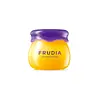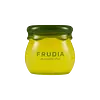What's inside
What's inside
 Key Ingredients
Key Ingredients

 Benefits
Benefits

 Concerns
Concerns

 Ingredients Side-by-side
Ingredients Side-by-side

Paraffinum Liquidum
EmollientPetrolatum
EmollientMicrocrystalline Wax
Emulsion StabilisingHydrogenated Castor Oil Dimer Dilinoleate
Skin ConditioningParaffin
PerfumingBeeswax
Emulsion StabilisingDiisostearyl Malate
EmollientRicinus Communis Seed Oil
MaskingSilica Dimethyl Silylate
EmollientGlyceryl Caprylate
EmollientButylene/Ethylene/Styrene Copolymer
Ethylene/Propylene/Styrene Copolymer
Water
Skin ConditioningHydrogenated Polyisobutene
EmollientCaprylic/Capric Triglyceride
MaskingCoco-Caprylate/Caprate
EmollientButylene Glycol
HumectantHydrolyzed Collagen
EmollientPrunus Armeniaca Kernel Oil
MaskingVitis Vinifera Seed Oil
Emollient1,2-Hexanediol
Skin ConditioningRibes Nigrum Leaf Extract
PerfumingSodium Hyaluronate
HumectantVaccinium Angustifolium Fruit Extract
Skin ProtectingCitrus Paradisi Seed Oil
PerfumingHoney Extract
HumectantMangifera Indica Seed Oil
EmollientPunica Granatum Seed Oil
EmollientSolanum Lycopersicum Seed Oil
EmollientAnemarrhena Asphodeloides Root Extract
Skin ConditioningTocopherol
AntioxidantPhenoxyethanol
PreservativeParfum
MaskingParaffinum Liquidum, Petrolatum, Microcrystalline Wax, Hydrogenated Castor Oil Dimer Dilinoleate, Paraffin, Beeswax, Diisostearyl Malate, Ricinus Communis Seed Oil, Silica Dimethyl Silylate, Glyceryl Caprylate, Butylene/Ethylene/Styrene Copolymer, Ethylene/Propylene/Styrene Copolymer, Water, Hydrogenated Polyisobutene, Caprylic/Capric Triglyceride, Coco-Caprylate/Caprate, Butylene Glycol, Hydrolyzed Collagen, Prunus Armeniaca Kernel Oil, Vitis Vinifera Seed Oil, 1,2-Hexanediol, Ribes Nigrum Leaf Extract, Sodium Hyaluronate, Vaccinium Angustifolium Fruit Extract, Citrus Paradisi Seed Oil, Honey Extract, Mangifera Indica Seed Oil, Punica Granatum Seed Oil, Solanum Lycopersicum Seed Oil, Anemarrhena Asphodeloides Root Extract, Tocopherol, Phenoxyethanol, Parfum
Hydrogenated Polyisobutene
EmollientSynthetic Beeswax
Emulsion StabilisingHydrogenated Castor Oil Dimer Dilinoleate
Skin ConditioningHydrogenated Vegetable Oil
EmollientHelianthus Annuus Seed Wax
Skin ConditioningSilica Dimethyl Silylate
EmollientEthylene/Propylene/Styrene Copolymer
Polyglyceryl-2 Triisostearate
EmulsifyingSucrose Tetrastearate Triacetate
EmollientPersea Gratissima Fruit Extract
EmollientMadecassic Acid
Skin ConditioningAsiaticoside
AntioxidantAsiatic Acid
Skin ConditioningMadecassoside
AntioxidantPanthenol
Skin ConditioningCentella Asiatica Extract
CleansingCamellia Sinensis Leaf Oil
AntioxidantCinnamomum Camphora Bark Oil
MaskingLeucine
Skin ConditioningPhenylalanine
MaskingMethionine
Skin ConditioningLysine
Skin ConditioningHistidine
HumectantIsoleucine
Skin ConditioningValine
MaskingThreonine
Tryptophan
MaskingHydrogenated Castor Oil
EmollientGlyceryl Caprylate
EmollientTocopherol
AntioxidantButyrospermum Parkii Butter
Skin ConditioningMauritia Flexuosa Fruit Oil
Skin ConditioningButylene/Ethylene/Styrene Copolymer
Water
Skin ConditioningGlycerin
HumectantPentaerythrityl Tetra-Di-T-Butyl Hydroxyhydrocinnamate
AntioxidantCaprylic/Capric Triglyceride
MaskingButylene Glycol
HumectantHydrogenated Lecithin
EmulsifyingPentylene Glycol
Skin ConditioningCaprylyl Glycol
EmollientPhytosterols
Skin ConditioningEthylhexylglycerin
Skin Conditioning1,2-Hexanediol
Skin ConditioningCitrus Aurantium Dulcis Peel Oil
MaskingCitrus Aurantium Bergamia Fruit Oil
MaskingCitrus Paradisi Peel Oil
MaskingMentha Viridis Leaf Oil
AstringentCitrus Nobilis Peel Oil
MaskingLimonene
PerfumingLinalool
PerfumingHydrogenated Polyisobutene, Synthetic Beeswax, Hydrogenated Castor Oil Dimer Dilinoleate, Hydrogenated Vegetable Oil, Helianthus Annuus Seed Wax, Silica Dimethyl Silylate, Ethylene/Propylene/Styrene Copolymer, Polyglyceryl-2 Triisostearate, Sucrose Tetrastearate Triacetate, Persea Gratissima Fruit Extract, Madecassic Acid, Asiaticoside, Asiatic Acid, Madecassoside, Panthenol, Centella Asiatica Extract, Camellia Sinensis Leaf Oil, Cinnamomum Camphora Bark Oil, Leucine, Phenylalanine, Methionine, Lysine, Histidine, Isoleucine, Valine, Threonine, Tryptophan, Hydrogenated Castor Oil, Glyceryl Caprylate, Tocopherol, Butyrospermum Parkii Butter, Mauritia Flexuosa Fruit Oil, Butylene/Ethylene/Styrene Copolymer, Water, Glycerin, Pentaerythrityl Tetra-Di-T-Butyl Hydroxyhydrocinnamate, Caprylic/Capric Triglyceride, Butylene Glycol, Hydrogenated Lecithin, Pentylene Glycol, Caprylyl Glycol, Phytosterols, Ethylhexylglycerin, 1,2-Hexanediol, Citrus Aurantium Dulcis Peel Oil, Citrus Aurantium Bergamia Fruit Oil, Citrus Paradisi Peel Oil, Mentha Viridis Leaf Oil, Citrus Nobilis Peel Oil, Limonene, Linalool
 Reviews
Reviews

Ingredients Explained
These ingredients are found in both products.
Ingredients higher up in an ingredient list are typically present in a larger amount.
1,2-Hexanediol is a synthetic liquid and another multi-functional powerhouse.
It is a:
- Humectant, drawing moisture into the skin
- Emollient, helping to soften skin
- Solvent, dispersing and stabilizing formulas
- Preservative booster, enhancing the antimicrobial activity of other preservatives
Butylene Glycol (or BG) is used within cosmetic products for a few different reasons:
Overall, Butylene Glycol is a safe and well-rounded ingredient that works well with other ingredients.
Though this ingredient works well with most skin types, some people with sensitive skin may experience a reaction such as allergic rashes, closed comedones, or itchiness.
Learn more about Butylene GlycolWe don't have a description for Butylene/Ethylene/Styrene Copolymer yet.
This ingredient is an emollient, solvent, and texture enhancer. It is considered a skin-softener by helping the skin prevent moisture loss.
It helps thicken a product's formula and makes it easier to spread by dissolving clumping compounds.
Caprylic Triglyceride is made by combining glycerin with coconut oil, forming a clear liquid.
While there is an assumption Caprylic Triglyceride can clog pores due to it being derived from coconut oil, there is no research supporting this.
Learn more about Caprylic/Capric TriglycerideWe don't have a description for Ethylene/Propylene/Styrene Copolymer yet.
Glyceryl Caprylate comes from glycerin and caprylic acid, a fatty acid from coconut. It has emollient and emulsifier properties.
As an emollient, it helps hydrate your skin. Emollients work by creating a barrier on your skin to trap moisture in, helping to keep your skin soft and smooth.
On the other hand, emulsifiers prevent ingredients (such as oil and water) from separating.
Learn more about Glyceryl CaprylateHydrogenated Castor Oil Dimer Dilinoleate is an oil and isn't fungal acne safe.
Hydrogenated Polyisobutene is a synthetic polymer. Polymers are compounds with high molecular weight. Hydrogenated Polyisobutene is an emollient and texture enhancer.
In one study, Hydrogenated Polyisobutene showed better skin hydration levels than Caprylic/Capric Triglyceride. As an emollient, it helps keep your skin soft and hydrated by trapping moisture in.
Hydrogenated Polyisobutene is often used as a mineral oil replacement.
Learn more about Hydrogenated PolyisobuteneThis silica is mainly used to thicken oils and suspend particles in oils. It is not water soluble.
According to the manufacturer, it:
The manufacturer also claims this ingredient to be useful in makeup.
In lipstick formulations, this ingredient improves color payoff, reduces pigment settling, and reduces oil bleeding. This ingredient also improves the grip of powder products such as dry shampoos.
Learn more about Silica Dimethyl SilylateTocopherol (also known as Vitamin E) is a common antioxidant used to help protect the skin from free-radicals and strengthen the skin barrier. It's also fat soluble - this means our skin is great at absorbing it.
Vitamin E also helps keep your natural skin lipids healthy. Your lipid skin barrier naturally consists of lipids, ceramides, and fatty acids. Vitamin E offers extra protection for your skin’s lipid barrier, keeping your skin healthy and nourished.
Another benefit is a bit of UV protection. Vitamin E helps reduce the damage caused by UVB rays. (It should not replace your sunscreen). Combining it with Vitamin C can decrease sunburned cells and hyperpigmentation after UV exposure.
You might have noticed Vitamin E + C often paired together. This is because it is great at stabilizing Vitamin C. Using the two together helps increase the effectiveness of both ingredients.
There are often claims that Vitamin E can reduce/prevent scarring, but these claims haven't been confirmed by scientific research.
Learn more about TocopherolWater. It's the most common cosmetic ingredient of all. You'll usually see it at the top of ingredient lists, meaning that it makes up the largest part of the product.
So why is it so popular? Water most often acts as a solvent - this means that it helps dissolve other ingredients into the formulation.
You'll also recognize water as that liquid we all need to stay alive. If you see this, drink a glass of water. Stay hydrated!
Learn more about Water